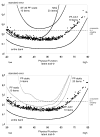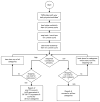The PROMIS Physical Function item bank was calibrated to a standardized metric and shown to improve measurement efficiency
- PMID: 24698295
- PMCID: PMC4465404
- DOI: 10.1016/j.jclinepi.2013.10.024
The PROMIS Physical Function item bank was calibrated to a standardized metric and shown to improve measurement efficiency
Abstract
Objective: To document the development and psychometric evaluation of the Patient-Reported Outcomes Measurement Information System (PROMIS) Physical Function (PF) item bank and static instruments.
Study design and setting: The items were evaluated using qualitative and quantitative methods. A total of 16,065 adults answered item subsets (n>2,200/item) on the Internet, with oversampling of the chronically ill. Classical test and item response theory methods were used to evaluate 149 PROMIS PF items plus 10 Short Form-36 and 20 Health Assessment Questionnaire-Disability Index items. A graded response model was used to estimate item parameters, which were normed to a mean of 50 (standard deviation [SD]=10) in a US general population sample.
Results: The final bank consists of 124 PROMIS items covering upper, central, and lower extremity functions and instrumental activities of daily living. In simulations, a 10-item computerized adaptive test (CAT) eliminated floor and decreased ceiling effects, achieving higher measurement precision than any comparable length static tool across four SDs of the measurement range. Improved psychometric properties were transferred to the CAT's superior ability to identify differences between age and disease groups.
Conclusion: The item bank provides a common metric and can improve the measurement of PF by facilitating the standardization of patient-reported outcome measures and implementation of CATs for more efficient PF assessments over a larger range.
Keywords: Computerized adaptive test; Health status; Item response theory; Patient-reported outcomes; Physical function; Questionnaire.
Copyright © 2014. Published by Elsevier Inc.
Figures


Similar articles
-
Psychometric properties of the PROMIS Physical Function item bank in patients receiving physical therapy.PLoS One. 2018 Feb 12;13(2):e0192187. doi: 10.1371/journal.pone.0192187. eCollection 2018. PLoS One. 2018. PMID: 29432433 Free PMC article.
-
Computerized Adaptive Testing Using the PROMIS Physical Function Item Bank Reduces Test Burden With Less Ceiling Effects Compared With the Short Musculoskeletal Function Assessment in Orthopaedic Trauma Patients.J Orthop Trauma. 2014 Aug;28(8):439-43. doi: 10.1097/BOT.0000000000000059. J Orthop Trauma. 2014. PMID: 24378399
-
Item response theory, computerized adaptive testing, and PROMIS: assessment of physical function.J Rheumatol. 2014 Jan;41(1):153-8. doi: 10.3899/jrheum.130813. Epub 2013 Nov 15. J Rheumatol. 2014. PMID: 24241485
-
Progress in assessing physical function in arthritis: PROMIS short forms and computerized adaptive testing.J Rheumatol. 2009 Sep;36(9):2061-6. doi: 10.3899/jrheum.090358. J Rheumatol. 2009. PMID: 19738214
-
Psychometric and Machine Learning Approaches to Reduce the Length of Scales.Multivariate Behav Res. 2021 Nov-Dec;56(6):903-919. doi: 10.1080/00273171.2020.1781585. Epub 2020 Aug 4. Multivariate Behav Res. 2021. PMID: 32749158 Free PMC article. Review.
Cited by
-
Evaluation of training in guideline-oriented biopsychosocial management of low back pain in occupational health services: Protocol of a cluster randomized trial.Health Sci Rep. 2021 Mar 4;4(1):e251. doi: 10.1002/hsr2.251. eCollection 2021 Mar. Health Sci Rep. 2021. PMID: 33728382 Free PMC article.
-
Improving Health for Older Adults With Pain Through Engagement: Protocol for Tailoring and Open Pilot Testing of a Mind-Body Activity Program Delivered Within Shared Medical Visits in an Underserved Community Clinic.JMIR Res Protoc. 2023 Dec 29;12:e52117. doi: 10.2196/52117. JMIR Res Protoc. 2023. PMID: 38157234 Free PMC article.
-
Establishing clinically-relevant terms and severity thresholds for Patient-Reported Outcomes Measurement Information System® (PROMIS®) measures of physical function, cognitive function, and sleep disturbance in people with cancer using standard setting.Qual Life Res. 2019 Dec;28(12):3355-3362. doi: 10.1007/s11136-019-02261-2. Epub 2019 Aug 13. Qual Life Res. 2019. PMID: 31410640 Free PMC article.
-
(Cost-)effectiveness of a personalized multidisciplinary eHealth intervention for knee arthroplasty patients to enhance return to activities of daily life, work and sports - rationale and protocol of the multicentre ACTIVE randomized controlled trial.BMC Musculoskelet Disord. 2023 Mar 4;24(1):162. doi: 10.1186/s12891-023-06236-w. BMC Musculoskelet Disord. 2023. PMID: 36869330 Free PMC article.
-
The NEI VFQ-25C: Calibrating Items in the National Eye Institute Visual Function Questionnaire-25 to Enable Comparison of Outcome Measures.Transl Vis Sci Technol. 2022 May 2;11(5):10. doi: 10.1167/tvst.11.5.10. Transl Vis Sci Technol. 2022. PMID: 35543680 Free PMC article.
References
-
- van der Linden WJ, Hambleton RK. Handbook of Modern Item Response Theory. Berlin: Springer; 1997.
-
- Wainer H, Dorans NJ, Eignor D, et al. Computerized Adaptive Testing: A primer. 2. Mahwah, NJ: Lawrence Erlbaum Associates; 2000.
-
- Ware JE, Jr, Bjorner JB, Kosinski M. Practical implications of item response theory and computerized adaptive testing: a brief summary of ongoing studies of widely used headache impact scales. Med Care. 2000;38:II73–II82. - PubMed
Publication types
MeSH terms
Grants and funding
- U01AR52155/AR/NIAMS NIH HHS/United States
- U01 AR052170/AR/NIAMS NIH HHS/United States
- U01 AR052181/AR/NIAMS NIH HHS/United States
- U01AR52170/AR/NIAMS NIH HHS/United States
- U01AR52158/AR/NIAMS NIH HHS/United States
- U01AR52171/AR/NIAMS NIH HHS/United States
- U01 AR052155/AR/NIAMS NIH HHS/United States
- U01AR52186/AR/NIAMS NIH HHS/United States
- U01 AR052171/AR/NIAMS NIH HHS/United States
- U01 AR052186/AR/NIAMS NIH HHS/United States
- U01 AR052177/AR/NIAMS NIH HHS/United States
- U01AR52177/AR/NIAMS NIH HHS/United States
- U01AR52181/AR/NIAMS NIH HHS/United States
- U01 AR052158/AR/NIAMS NIH HHS/United States
LinkOut - more resources
Full Text Sources
Other Literature Sources
Medical
Miscellaneous

